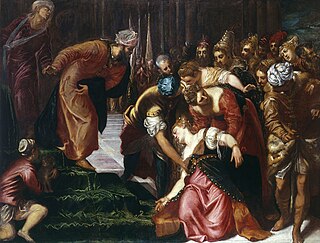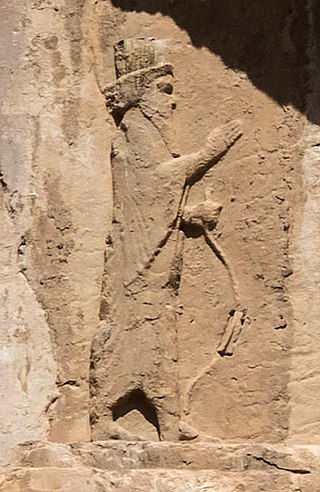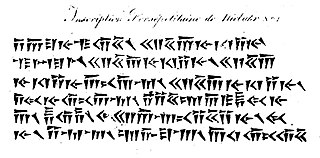
Xerxes I was a Persian ruler who served as the fourth King of Kings of the Achaemenid Empire, reigning from 486 BC until his assassination in 465 BC. He was the son of Darius the Great and Atossa, a daughter of Cyrus the Great. In Western history, Xerxes is best known for his invasion of Greece in 480 BC, which ended in Persian defeat.

Darius I, commonly known as Darius the Great, was a Persian ruler who served as the third King of Kings of the Achaemenid Empire, reigning from 522 BCE until his death in 486 BCE. He ruled the empire at its territorial peak, when it included much of Western Asia, parts of the Balkans and the Caucasus, most of the Black Sea's coastal regions, Central Asia, the Indus Valley in the far east, and portions of North Africa and Northeast Africa including Egypt (Mudrâya), eastern Libya, and coastal Sudan.
This article concerns the period 489 BC – 480 BC.

Ahasuerus is a name applied in the Hebrew Bible to three rulers and to a Babylonian official in the Book of Tobit. It is a transliteration of either Xerxes or Artaxerxes; both are names of multiple Achaemenid dynasty Persian kings.

Artaxerxes I was the fifth King of Kings of the Achaemenid Empire, from 465 to December 424 BC. He was the third son of Xerxes I.

Artabazos was a Persian general in the army of Xerxes I, and later satrap of Hellespontine Phrygia under the Achaemenid dynasty, founder of the Pharnacid dynasty of satraps. He was the son of Pharnaces, who was the younger brother of Hystaspes, father of Darius I. Artabazos was therefore a first cousin of the great Achaemenid ruler Darius I.

The Greco-Persian Wars were a series of conflicts between the Achaemenid Empire and Greek city-states that started in 499 BC and lasted until 449 BC. The collision between the fractious political world of the Greeks and the enormous empire of the Persians began when Cyrus the Great conquered the Greek-inhabited region of Ionia in 547 BC. Struggling to control the independent-minded cities of Ionia, the Persians appointed tyrants to rule each of them. This would prove to be the source of much trouble for the Greeks and Persians alike.

Atossa was an Achaemenid empress. She was the daughter of Cyrus the Great, and the wife of Darius the Great.
Mardonius was a leading Persian military commander during the Persian Wars with Greece in the early 5th century BC who died at the Battle of Plataea.

In the writings of the Ancient Greek chronicler Herodotus, the phrase earth and water is used to represent the demand by the Persian Empire of formal tribute from the cities or people who surrendered to them.

Masistes was a Persian prince of the Achaemenid Dynasty, son of king Darius I and of his wife Atossa, and full brother of king Xerxes I. He was satrap (governor) of Bactria during his brother's reign, where he attempted to start a revolt in 478 BC.

The Satrapy of Lydia, known as Sparda in Old Persian, was an administrative province (satrapy) of the Achaemenid Empire, located in the ancient kingdom of Lydia, with Sardis as its capital.
Maka was a satrapy (province) of the Achaemenid Empire and later a satrapy of the Parthian and Sassanian empires, corresponding to Greek Gedrosia, in the barren coastal areas of modern Pakistan and Iranian Baluchistan. Alternatively, it may have corresponded to modern day Bahrain, Qatar, and United Arab Emirates, plus the northern half of Oman.

The first Persian invasion of Greece, during the Greco-Persian Wars, began in 492 BC, and ended with the decisive Athenian victory at the Battle of Marathon in 490 BC. The invasion, consisting of two distinct campaigns, was ordered by the Persian king Darius the Great primarily in order to punish the city-states of Athens and Eretria. These cities had supported the cities of Ionia during their revolt against Persian rule, thus incurring the wrath of Darius. Darius also saw the opportunity to extend his empire into Europe, and to secure its western frontier.

The second Persian invasion of Greece occurred during the Greco-Persian Wars, as King Xerxes I of Persia sought to conquer all of Greece. The invasion was a direct, if delayed, response to the defeat of the first Persian invasion of Greece at the Battle of Marathon, which ended Darius I's attempts to subjugate Greece. After Darius's death, his son Xerxes spent several years planning for the second invasion, mustering an enormous army and navy. The Athenians and Spartans led the Greek resistance. About a tenth of the Greek city-states joined the 'Allied' effort; most remained neutral or submitted to Xerxes.

Hystaspes or Guštāsp, was a Persian satrap of Bactria and Persis. He was the father of Darius I, emperor of the Achaemenid Empire, and Artabanus, who was a trusted advisor to both his brother Darius as well as Darius's son and successor, Xerxes I.

The Achaemenid Empire or Achaemenian Empire was the ancient Iranian empire founded by Cyrus the Great of the Achaemenid dynasty in 550 BC, also known as the First Persian Empire. Based in Western Asia, it was the largest empire the world had ever seen at its time, spanning a total of 5.5 million square kilometres from the Balkans and Egypt in the west to Central Asia and the Indus Valley in the east.

The Achaemenid conquest of the Indus Valley refers to a process beginning in the 6th century BCE and ending in the 4th century BCE, whereby the Achaemenid Persian Empire established control over the northwestern regions of the Indian subcontinent, today predominantly comprising the territory of Pakistan. The first of the two main invasions was conducted around 535 BCE by Cyrus the Great, who annexed the areas to the west of the Indus River, consolidating the early eastern border of the Achaemenid Empire. With a brief pause after Cyrus' death, the campaign continued under Darius the Great, who began to re-conquer former provinces and further expand Persia's political boundaries. Around 518 BCE, Persian armies under Darius crossed the Himalayas into India to initiate a second period of conquest by annexing regions up to the Jhelum River in Punjab.
Hydarnes II, also known as Hydarnes the Younger was a Persian commander of the Achaemenid Empire in the 5th century BC. He was the son of Hydarnes, satrap of the Persian empire and one of the seven conspirators against Gaumata.

Achaemenid Macedonia refers to the period in which the ancient Greek Kingdom of Macedonia was under the sway of the Achaemenid Persians. In 512/511 BC, the Persian general Megabyzus forced the Macedonian king Amyntas I to make his kingdom a vassal of the Achaemenids. In 492 BC, following the Ionian Revolt, the Persian general Mardonius firmly re-tightened the Persian grip in the Balkans, making Macedon a fully subordinate kingdom within the Achaemenid domains and part of its administrative system. Macedonia served the Achaemenid Empire during the Greco-Persian Wars in their invasion of mainland Greece. They regained independence following the defeat and withdrawal of the Achaemenid Empire in 479 BC.















